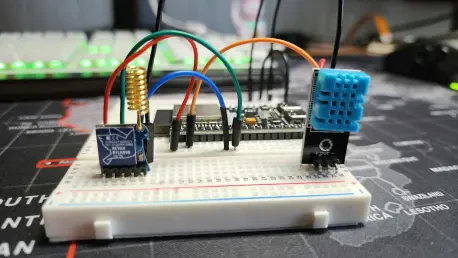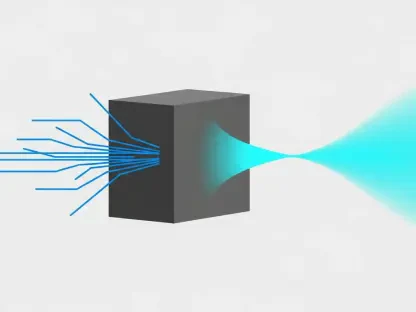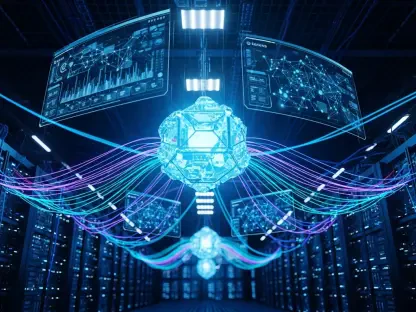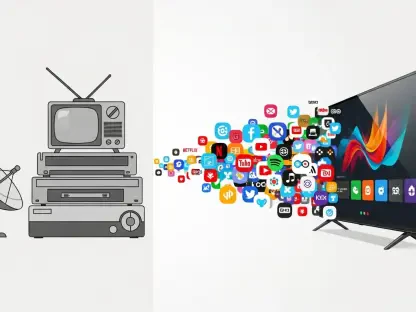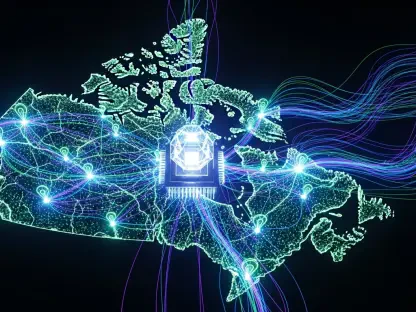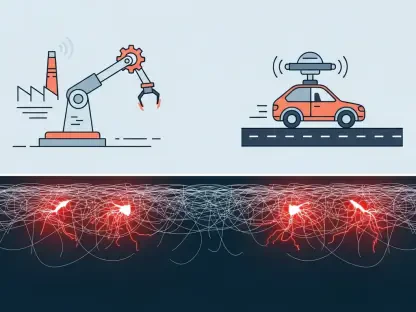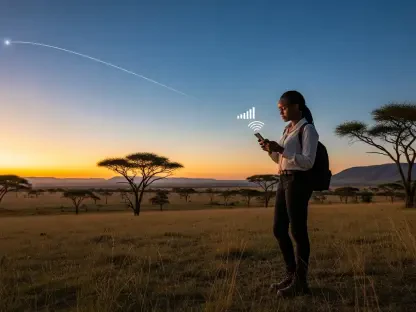In a world where billions of devices are interconnected, the challenge of ensuring reliable, long-range, and energy-efficient communication has never been more pressing. Imagine a smart city where sensors monitor air quality, traffic flow, and utility usage in real-time, all while operating on minimal power and covering vast distances. This vision is becoming reality through advancements in low-power wide-area network (LPWAN) technologies, with LoRa standing out as a frontrunner. This review delves into the latest fourth-generation LoRa Plus chipset family, exploring how it pushes the boundaries of Internet of Things (IoT) connectivity. By addressing modern demands for scalability and performance, this technology promises to redefine how industries and communities stay connected.
Understanding LoRa Technology and Its Latest Evolution
LoRa technology has long been recognized as a cornerstone of LPWAN solutions, enabling long-range communication with remarkably low power consumption. Designed to support IoT applications, it facilitates data transmission over distances of several miles while preserving battery life for years. This balance of range and efficiency has made it a preferred choice for diverse sectors, from agriculture to urban planning.
The introduction of the fourth-generation LoRa Plus chipset family marks a significant milestone in this journey. Developed by Semtech, a leader in semiconductor solutions, this latest iteration builds on the strengths of its predecessors while addressing emerging needs in the IoT landscape. With enhanced capabilities tailored for complex, data-intensive environments, the chipset family responds to the growing call for robust connectivity solutions.
The relevance of LoRa in today’s IoT ecosystem cannot be overstated. As the number of connected devices surges, the demand for scalable and cost-effective networks intensifies. This technology offers a pathway to meet those needs, supporting applications that require minimal infrastructure and maximum reach, thereby shaping the future of smart, connected systems.
Key Features of the Fourth-Generation LoRa Plus Chipset
Multi-Protocol Support for Seamless Integration
One of the standout attributes of the LoRa Plus chipset is its ability to support multiple IoT protocols. By integrating with standards such as Bluetooth Low Energy (BLE), Zigbee, and Amazon Sidewalk through external microcontrollers, it provides manufacturers with unparalleled flexibility. This modularity allows for tailored solutions that can adapt to specific use cases without requiring extensive redesigns.
The importance of such interoperability is evident in fragmented IoT ecosystems. In smart home environments, for instance, devices often operate on different protocols, creating compatibility challenges. The chipset’s design enables seamless communication across these systems, fostering a cohesive network where diverse gadgets work in harmony.
This feature also benefits industrial applications, where integration with existing infrastructure is critical. By bridging various communication standards, the technology ensures that new deployments can coexist with legacy systems, reducing costs and accelerating adoption in sectors that rely on interconnected equipment.
Extended Range and Superior Power Efficiency
Another defining advancement in the LoRa Plus chipset is its doubled transmission range, achieved through a 5–6 dB improvement in link budget. This enhancement means devices can either communicate over twice the distance or operate at a fraction of the power compared to earlier generations. Such progress is a game-changer for IoT deployments in remote or hard-to-reach areas.
The implications for infrastructure are significant. With greater range, fewer gateways are needed to cover expansive regions, slashing deployment costs for network operators. This efficiency is particularly valuable in rural or industrial settings where installing additional hardware can be logistically challenging and expensive.
Moreover, the power savings translate to longer device lifespans, a crucial factor for applications like environmental monitoring or asset tracking. By minimizing energy consumption without sacrificing performance, the chipset supports sustainable IoT solutions that align with global efforts to reduce energy footprints.
Higher Data Throughput with Fast Long-Range Communication (FLRC)
The introduction of Fast Long-Range Communication (FLRC) technology in the sub-gigahertz band sets the LoRa Plus chipset apart from traditional LPWAN offerings. Capable of supporting data rates up to 2.6 Mbps, it far exceeds the limits of earlier LoRa implementations, opening doors to data-intensive applications previously out of reach.
Compared to alternatives like Bluetooth Low Energy, FLRC offers superior range and building penetration, making it ideal for environments with physical barriers. This capability positions the technology as a strong contender for emerging use cases, particularly those driven by artificial intelligence (AI), such as smart cameras and drones requiring robust data transmission.
The shift toward higher throughput reflects the evolving needs of IoT, where devices increasingly handle complex tasks like image processing or real-time analytics. By accommodating these requirements, the chipset ensures that LoRa remains relevant in a landscape where speed and reliability are paramount.
Recent Developments and Market Dynamics
Semtech’s commitment to LoRa innovation remains steadfast despite corporate transitions, including the integration of Sierra Wireless. A notable 20% year-over-year increase in research and development funding underscores a dedication to advancing the technology, ensuring it keeps pace with industry demands.
Market trends are also shaping the trajectory of LoRa advancements. The growing emphasis on edge AI and the need for higher data rates have prompted enhancements like FLRC, aligning the technology with modern IoT priorities. These shifts highlight a broader movement toward smarter, more responsive connected systems.
To counter past perceptions of reduced activity, Semtech has ramped up its visibility through strategic product launches and active participation in industry events like The Things Conference. Such efforts aim to reassure stakeholders of the company’s ongoing focus on LoRa, reinforcing trust and momentum in a competitive market.
Real-World Impact and Applications
LoRa technology powers a wide array of applications across multiple industries, demonstrating its versatility. From utilities leveraging it for water and gas metering to logistics firms using it for asset tracking, the technology supports critical functions with efficiency and reliability.
The enhanced features of the LoRa Plus chipset cater to newer sectors as well. In smart homes, its multi-protocol support enables integration with diverse devices, enhancing user experiences. Similarly, AI-enabled applications like drones and surveillance systems benefit from improved data rates, expanding the scope of what LoRa can achieve.
With an installed base exceeding 450 million devices, the technology’s footprint is vast, spanning public safety solutions like gunshot detectors in schools to environmental sensors. This widespread adoption drives continuous innovation, as the demand for incremental improvements fuels further development to address diverse operational needs.
Challenges and Barriers to Overcome
Despite its strengths, LoRa technology faces technical hurdles, particularly in balancing data-intensive applications with low power consumption. The introduction of FLRC addresses this to an extent, but ongoing refinements are necessary to fully meet the demands of next-generation IoT workloads.
Market challenges also persist, with past perceptions of reduced visibility impacting stakeholder confidence. Semtech is actively working to rebuild trust through increased engagement and transparency, ensuring the technology’s value proposition remains clear to partners and customers alike.
Simplifying global deployment is another area of focus. Features like the single global SKU design help address regional regulatory compliance by dynamically adjusting power outputs, reducing complexity for manufacturers. Continued efforts in this direction are essential to streamline international rollouts and maintain competitive advantage.
Future Prospects for LoRa Plus and Beyond
Looking ahead, the trajectory of LoRa technology appears promising, with indications of a fifth-generation chipset already in development. Such progress suggests a commitment to staying ahead of IoT trends, ensuring the platform evolves in step with market expectations.
Potential breakthroughs, including deeper AI integration and broader multi-protocol capabilities, could further enhance LoRa’s applicability. These advancements would cater to increasingly sophisticated IoT demands, from autonomous systems to real-time data processing in dynamic environments.
The long-term impact on the IoT industry is substantial, particularly in enabling scalable solutions for smart cities and industrial automation. By offering cost-effective, reliable connectivity, LoRa is poised to play a pivotal role in shaping how interconnected systems transform daily life and operational efficiencies.
Final Thoughts and Next Steps
Reflecting on the journey of the fourth-generation LoRa Plus chipset, it becomes evident that Semtech has achieved remarkable strides in enhancing range, power efficiency, and data throughput. These advancements solidify LoRa’s position as a vital component of the IoT ecosystem, adept at meeting both traditional and cutting-edge needs.
Moving forward, stakeholders should prioritize collaboration to address remaining challenges, particularly in optimizing data handling for power-constrained devices. Exploring partnerships for AI integration could unlock new potential, ensuring LoRa adapts to future complexities.
Additionally, sustained efforts to boost market visibility and simplify global deployments prove crucial. By focusing on these actionable steps, the technology can expand its reach, paving the way for innovative applications that redefine connectivity across industries.
